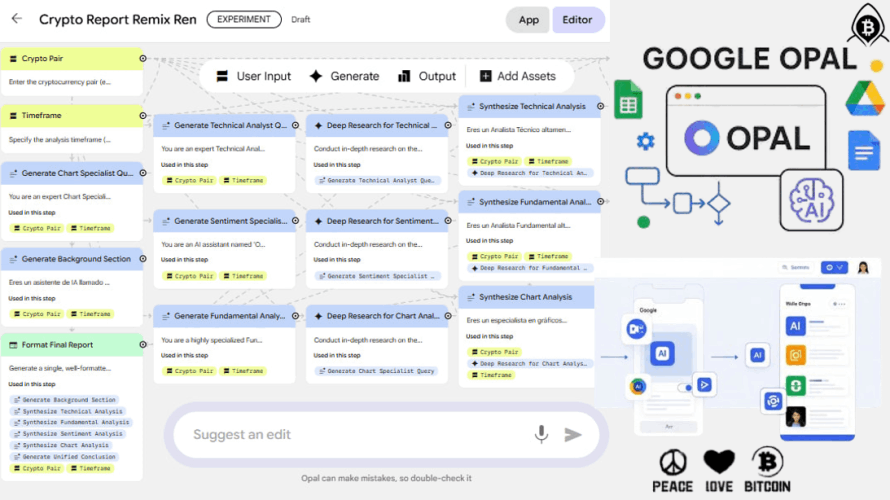Google's Opal: The Silent Revolution for Creating AI Apps Without Coding.
Artificial intelligence is no longer simply a topic for scientists or developers: it's part of our daily lives, our work ecosystem, and our business and creativity tools. What once seemed like science fiction—creating intelligent applications, prototypes, and automation—is now being democratized, becoming accessible to people without technical training.
In this context, Google has put its new experiment on everyone's radar: Opal (https://opal.withgoogle.com), a Google Labs platform whose purpose is to allow anyone—from entrepreneurs with emerging ideas to creative and marketing teams—to create, edit, and share artificial intelligence mini-applications (AI mini-apps) without writing a single line of code.
To understand Opal, it's worth reviewing several convergent trends:
- Low-code / No-code - In recent years, we've seen a boom in tools that allow you to design applications, automations, and workflows without having to code: Zapier, Airtable, Make, n8n, etc. This responds to a demand: many entrepreneurs or creators have ideas but don't program, or don't have the resources to hire developers.
- Generative AI and Large Language Models (LLMs) - Models like OpenAI's GPT, Google's equivalents like Gemini, and multimedia tools (text, image, video) that can be used for content generation, analysis, language processing, data transformation, etc. This power, combined with ease of use, is the fuel that makes something like Opal possible.
- Workflow visualization + conversational editing - It's not enough to simply give commands in natural language; being able to see what's happening, edit it, and adjust parameters visually gives greater control, confidence, and allows for faster iteration.
- Public beta / experimentation and collective learning - Modern AI platforms are increasingly being released first in beta form, rather than in final versions, to gather feedback, learn, and iterate. Google Labs follows this pattern.
It's at this intersection that Opal appears. What is Opal? - Opal is an experimental no-code/low-code tool created by Google Labs, aimed at enabling the creation of artificial intelligence mini-applications through:
- Natural language descriptions. That is, you tell Opal what you want it to do; for example, "create an assistant that reviews customer comments and classifies those that are positive, negative, or neutral, and generates a weekly summary." Opal turns that idea into a visual workflow that links instructions, calls to AI models, data transformation, etc.
- Visual editing: You can see each step of the flow, adjust each section, prompt, connect tools, insert new steps, and reorganize. All without touching code.
- Reusable components/templates ("starter templates" or "demo gallery"): The platform comes with examples that you can use directly or remix to adapt them to your needs. This speeds up getting started with something useful.
- Sharing: Once the mini-app is created, you can share it for others to use with their Google accounts. This facilitates collaboration, feedback, and real-world testing.
Opal is in public beta and is currently only available to users in the United States. I think Google launched it this way to collect usage data in real-world environments before rolling it out.
ADVANTAGES:
From my perspective as an entrepreneur, Opal's main advantages and what makes it especially attractive are:
- Speed of prototyping - Instead of spending weeks developing an idea, designing the UI, connecting the backend, and validating software, Opal allows you to bring it to life in hours or even minutes. This gives you a competitive advantage.
- Lower technical barriers - If you have an idea, you don't need to know how to code. You can focus on what the app does, rather than how it's developed. This opens up opportunities for creators, entrepreneurs, and people in countries or regions where access to developers is more expensive or limited.
- Rapid iteration - You can change an idea, adjust a workflow step, see what happens, and go back. Designed for learning, experimenting, and improving with feedback.
- Collaborative - Sharing, allowing others to test your mini-app, give you suggestions, adapt it, etc. You can build a community from the start.
- Accessibility as a market advantage - For small startups, freelancers, marketing, or creative teams, it can allow you to do things that previously only companies with more resources could do.
However, no revolution is perfect. Opal also has barriers, risks, and limitations that should be taken into account:
- Limited geographic availability - Currently, it's only available in the US. If you're in another part of the world, you may not be able to access it or you may have restrictions. This limits immediate reach. Although I can tell you that it has worked very well for me using a VPN.
- Transparency of models/performance - Google hasn't publicly identified all the specific models, their limits, latency times for complex tasks, resource consumption, etc. For critical business uses, this lack of knowledge can create risks (unexpected errors, biases, privacy breaches, etc.).
- Capacity in complex scenarios - Opal is designed for "mini-apps" and prototypes. It's not designed (at this stage, at least as far as I know) for massive, highly customized applications with extreme security or performance requirements. If your application is large (data volumes, algorithmic complexity, legal compliance, etc.), you may need more robust tools.
- Privacy, security, and compliance - Whenever a platform handles Artificial Intelligence, models, external data, prompts that may include sensitive data, the question of where the data is stored, who has access, how it's used, whether there are audits, etc., arises. Google generally "has good practices" 😁😁, but since it's experimental, we'll need to review the terms, policies, and compliance with local laws in different countries.
- Future costs / unknown business model - It's currently in public beta. It's unclear how it will be monetized, what costs it will have, what limitations will be imposed, whether there will be free vs. paid plans, quotas, etc. If you rely heavily on Opal for your business, it's a good idea to plan for the possibility of restrictions.
- Language/Culture/Localization - Initially described in English and only for the US. For markets that speak other languages, translation, cultural adaptation, and localization may be required, which adds friction. Also, as I mentioned earlier, you'll have to use a VPN.
Opal, in my humble opinion, doesn't replace serious development, but it fills a powerful gap between idea and prototype, between creativity and action. Some concrete ideas that could catapult Opal's value for you as an entrepreneur:
- Marketing and Personalized Content - Create mini-apps or assistants that generate slogans, advertising copy, feedback summaries, opinion classification, creative ideas for campaigns, etc.
- Education and Training - Teachers or coaches can build interactive apps for students, simulations, automated quizzes, learning assistants, etc.
- Customer Service/Support - Simple chatbots, ticket analysis tools, automated responses with a summary of the essentials, etc.
- Research and Analysis - For entrepreneurs conducting market research: collect data, automatically analyze it, generate reports, and visualize insights.
- AI Product Prototyping - Validate ideas with tangible results for investors, stakeholders, and customers without hiring a developer or investing heavily.
- Internal Business Automation - Internal workflows, small processes like organizing emails, extracting information from documents, automatically generating internal content, etc.
How Transformative Can Opal Be?
- If Opal manages to overcome its initial limitations—expanding geographic availability, offering versions in multiple languages, adding external integrations, improving model transparency, and offering robust security—it could become a transformative tool for many entrepreneurs, especially in emerging countries where technical resources are less accessible.
- It could help close gaps in digital skills, access to technology, and distributed innovation. People who until now viewed AI as something remote could use it to solve local problems, create businesses, generate employment, and so on.
- Third-party ecosystems are also likely to emerge: tutorials, communities, shared templates, mini-app marketplaces, user-made integrations, and consulting services to leverage them. This makes it more powerful the more users it has.
- On the business side, it could be seen as a complementary rather than a substitute tool: companies will still need developers, systems architects, security, and compliance experts, but Opal will allow them to prototype ideas internally before investing heavily or reduce certain operating costs.
As a freelancer and ICT promoter, I believe Opal has profound implications:
- Democratization of innovation: By lowering the technical barrier, many more people in different countries will have the opportunity to innovate. This could lead to the growth of local startup ecosystems, adapted regional solutions, and diverse cultural products.
- Growing innovative competition: Large and small companies will compete not only for capital but also for ideas, agility, and creativity. Tools like Opal empower creativity and allow speed of execution to be a differentiating factor.
- Educational impact: Institutes, universities, and bootcamps could incorporate the practical use of tools like Opal to teach computational thinking, logic, AI, and prototyping. Not as deep code, but as flow design with AI, which is relevant today and tomorrow.
- Decentralization of technological development: Instead of having to rely on specialized developers, mixed, hybrid teams could assume greater technical autonomy, which shortens cycles, reduces dependency, and improves the local adaptation of solutions.
- Globalization of solutions: Ideas from the US or Europe won't be the only ones who will have an advantage. If Google finally opens Opal to other countries, other regions will contribute ideas, cultural adaptations, languages, etc., enriching the global landscape.
I believe Opal is a generational opportunity for technological entrepreneurship, distributed innovation, and for more people to actively participate in the creation of AI applications. It's not perfect, it doesn't replace traditional development tools, nor will it solve all technical problems. But if played well, it can be like the digital paintbrush that turns ideas into something tangible, fast, and accessible. This ability to "do instead of imagine" can make the difference between many ideas that remain sketches and many that become action—and in the business world, early action counts.
Whether you lead projects, start businesses, or are self-employed, Opal can be a powerful ally: it allows you to experiment, reduce risks, launch tests, validate ideas, and generate prototypes in an accessible and low-cost way. If you ask me, Opal is one of those moments where technology truly serves human creativity. If you harness its benefits, you can generate enormous value, advance in innovation, and perhaps open doors we haven't yet imagined.
OTHER LINKS 👍:
🔎 Discover Cryptocurrency Trading with AI. 🤖 Robot Trader (➕💲5️⃣ FREE). 💡 LET TECHNOLOGY WORK FOR YOU 😎
- 🤖 Bot GPTrading: http://bit.ly/3IplW6G
- 📈 Zaffex Broker: http://bit.ly/468Z6tU
- ✍️ Tutorials: https://www.youtube.com/@TeamReferralFamily
💳 Get the BANCUS Cryptocurrency Debit Card 🥳 NO KYC VERIFICATION REQUIRED. Participating in their REFERRAL PROGRAM allows you to accumulate sufficient funds to purchase it WITHOUT INVESTMENT.
- 🔗 https://bit.ly/3HndJzE
- 💰 Referral Reward Levels 👉
Card Purchase:1º-$7.50, 2º-$11.25, 3º-$7.50;Of the Top-Up Amount:1º-0.285%, 2º-0.43%, 3º-0.285% - 👉 Plastic Card: ATM: $200 daily, Merchant: $2,500 monthly, Reload: $2,500 maximum | Metal Card: ATM: $600 daily, Merchant: $2,500 daily, Reload: $50,000 maximum
💰 YouHodler Cloud Miner - https://app.youhodler.com/sign-up?ref=X7MTQH9M - Crypto mining simulator with a reward system that rewards users for completing simple tasks. The idea is to simplify and gamify the Bitcoin mining process, without using the user's device's CPU resources. Cloud Miner is a unique feature of YouHodler, the perfect tool to earn extra benefits for using the app in the form of a simple game.
"If you don't find a way to earn money while you sleep, you'll work until you die" - Warren Buffett






































